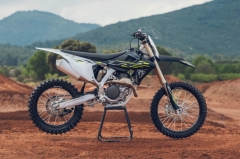BMW patents a new flexible carbon swingarm
This new swingarm could be used for the next-generation BMW HP4.

The BMW HP4 is already a carbon clad supersport bike making it one of the lightest liter-bikes to roll out of the German motorcycle manufacturer. It tips the scales weighing in at only 146 kg. This motorcycle just shows how fond BMW is of using composite lightweight materials to give their fastest bikes even better performance. Now, the German manufacturer has just filed a patent for a flexible carbon swingarm that they could use for the next generation HP4. With the new lightweight suspension component, it could allow the motorcycle to shed even more weight. The new type of motorcycle swingarm works in a totally different way unlike anything else before it.

Normally, a motorcycle’s frame holds the engine and its rider. Bolted on to its frame are its suspension components which include the front forks that connect directly to the front wheel. Meanwhile, the swingarm is fixed to the rear wheel which pivots to the point where it is mounted to the frame or engine. Somewhere along the length of the swingarm attaches a shock absorber that is designed to keep the rear wheel in contact with the ground as it encounters road bumps and imperfections. This makes the swingarm a pretty complex component of a motorcycle’s frame, carefully measured and engineered to make sure it works on constantly holding the rear wheel on the ground.
BMW thinks that this tried and tested design is too complicated and is looking to simplify things. The patent filed by BMW features a new design made of carbon fiber forming an integral part of the motorcycle’s frame. Instead of being a rigid piece that pivots on its connecting point to the bike’s frame, it behaves similarly to the way leaf springs operate on classic cars. The spring itself is flexible enough along one axis but remains rigid and resistant to flex on the other. The swingarm's carbon fiber material allows the design to flex vertically, but not laterally. However, this doesn’t mean that it no longer necessitates some sort of additional damping system to keep it from bouncing almost uncontrollably.

However, this new design doesn’t come without caveats. First and foremost, carbon fiber ages over time and becomes brittle. This phenomenon is known as carbon fiber fatigue. This effectively makes it difficult to put an approximation of its effective lifespan before its structural integrity is compromised. One instance that happened in the past is when one of the carbon-era F1 cars from the mid-2000s had their front ends literally fall off while being used in the Laguna Seca track. This happened to be one of Michael Schumacher’s old Ferrari F1 cars.
Secondly, the significant reduction of weight on the swingarm and rear suspension system means that the calculation based on the engine’s power delivery would also have to be completely reworked. While the new design looks like it could easily be fitted into an S1000RR frame, it’s fair to say that some serious work has to be done on its engine’s tuning and mapping to make it road and track-worthy.
Nevertheless, this new patent still has the potential to change the game altogether when it comes to fitting new suspension systems for future supersport bikes. We’ll wait and see when this new patent transcends from the drawing board, and into new motorcycle hardware.
Tagged Under
Related Articles
-
BMW develops its new road sensing traction control system / News
BMW’s new road surface-sensitive traction control system makes use of cameras and acoustic sensors to make the necessary adjustments to its traction control and ABS settings.
-
BMW’s patent filing of an updated C1 scooter emerges online / News
BMW’s patent filing sketches of an updated C1 modular scooter with a detachable roof emerges online with car-like levels of safety and powered by an eclectic motor.
Latest News
-
Hero MotoCorp says more small-displacement Harley-Davidsons are coming soon / News
Hero MotoCorp has confirmed that it will be working on more 440cc models for Harley-Davidson, following the success of the X440.
-
Triumph’s TF 450-X is the ultimate motocross machine / News
Triumph enters the 450 motocross class with the TF 450-X, offering premium components, smart updates, and advanced rider aids out of the box.
-
CFMOTO's new 750SR-S sportbike launched in international market / News
CFMOTO has unveiled the 750 SR-S in the global market, hinting at a potential launch in the Philippines in the near future.





